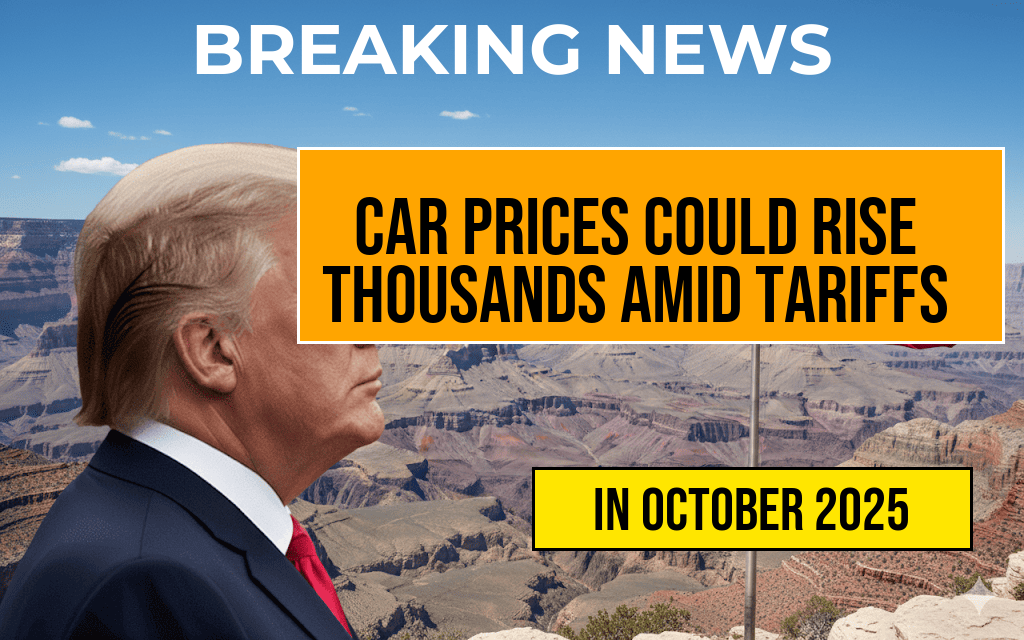Consumers and industry analysts are closely monitoring potential changes in the U.S. automotive market as President Trump’s recent tariff threats could lead to significant increases in new car prices. According to economic experts, the possibility of imposing new tariffs on imported vehicles and automotive parts could add as much as $5,286 to the average price of a new car. This potential surge comes amid ongoing trade negotiations and concerns over supply chain disruptions, which could ripple through the automotive sector, affecting both manufacturers and consumers. The threat of tariffs has already caused some automakers to reconsider their pricing strategies and supply chain plans, raising questions about how much of the cost increase will be passed onto buyers. With the U.S. automotive market being a major contributor to the economy, even a small uptick in vehicle prices could influence buying behaviors and overall market stability.
Potential Impact of Tariffs on New Car Prices
Estimating the Price Increase
Economists at Forbes and industry analysts suggest that a tariff rate of 25% on imported vehicles and parts could inflate the average price of a new car by up to $5,286. This figure is based on current import volumes and the typical profit margins within the automotive industry. For context, the average transaction price for a new car in the United States was approximately $48,000 in early 2023, according to NADA. An increase of this magnitude would not only make vehicles less affordable for many consumers but could also distort the competitive landscape, favoring domestic automakers who might be less affected by import tariffs.
Which Vehicles Are Most Vulnerable?
- Imported luxury models: Brands like BMW, Mercedes-Benz, and Audi could see the largest price hikes due to their heavy reliance on imported components and vehicles.
- Electrified vehicles: Electric vehicles often depend on imported batteries and advanced parts, increasing their vulnerability to tariff-induced cost increases.
- Mid-range and economy cars: While these models are generally less affected, automakers might still pass on some costs to maintain profit margins, especially in a competitive market.
Industry Response and Market Dynamics
Automaker Strategies
Manufacturers are already adjusting their strategies in anticipation of potential tariffs. Some are exploring ways to increase local sourcing of parts or shifting production facilities to the U.S. to mitigate the impact. Others may absorb some of the cost increases to avoid losing market share, though this could impact their profitability. For example, Ford and General Motors have historically maintained significant manufacturing operations within the U.S., but many foreign automakers rely heavily on imports, making them more susceptible to price hikes.
Consumer Implications
| Vehicle Segment | Estimated Price Increase |
|---|---|
| Luxury SUVs | $4,500 – $6,000 |
| Mid-range Sedans | $3,000 – $4,500 |
| Economy Cars | $2,000 – $3,200 |
These increases could lead to a slowdown in new vehicle sales, especially among budget-conscious buyers. Car dealerships may also experience shifts in inventory, with some models becoming less attractive due to higher prices, potentially impacting overall sales volume and dealer profits.
Broader Economic and Political Considerations
Trade Policy Uncertainty
The threat of tariffs adds a layer of unpredictability to the automotive market, influencing both supply chain decisions and consumer confidence. Historically, trade tensions have led to volatile market conditions, which can deter new car purchases and disrupt production schedules. The U.S. government’s approach to tariffs remains a subject of debate, with critics warning that escalation could harm economic growth and consumer purchasing power.
Global Supply Chain Disruptions
Many automakers depend on complex international supply chains for crucial components such as semiconductors, batteries, and specialized metals. Tariffs could increase costs and delay deliveries, further compounding the price pressures on new vehicles. Industry leaders are cautioning that ongoing trade disputes could exacerbate existing supply chain issues, leading to shortages and increased vehicle prices beyond initial estimates.
Looking Ahead
While the final decision on tariffs remains uncertain, automakers and consumers alike are preparing for potential price adjustments. Market analysts advise buyers to consider locking in purchases before any new tariffs come into effect or to explore options such as leasing or used vehicles as alternatives. Policymakers, meanwhile, face mounting pressure to balance trade negotiations with economic stability, recognizing that sharp price increases could dampen the momentum of the automotive sector — a crucial component of the U.S. economy.
For more insights into the economic impacts of tariffs and trade policy, visit Wikipedia’s page on trade wars or review recent analyses from Forbes.
Frequently Asked Questions
What is the main reason behind the potential increase in new car prices?
The potential increase in new car prices is primarily due to Trump’s tariff threat on imported vehicles and parts, which could lead to costs rising by up to 5286 dollars.
How much could new car prices increase if tariffs are implemented?
If tariffs are enforced, new car prices could soar by as much as 5286 dollars, significantly impacting consumers and manufacturers alike.
Which types of vehicles would be most affected by the tariff threat?
The imported vehicles and parts that rely on international supply chains would be most affected, potentially leading to higher prices across a wide range of car models.
What could be the impact of these price increases on consumers?
Consumers may face higher car prices, making new vehicles less affordable and possibly reducing sales in the automotive market.
Are there any potential alternatives for consumers to avoid higher car prices?
Consumers might consider options such as purchasing used cars, exploring domestically produced vehicles, or delaying purchases until market conditions stabilize to mitigate the impact of potential tariffs.

Leave a Reply